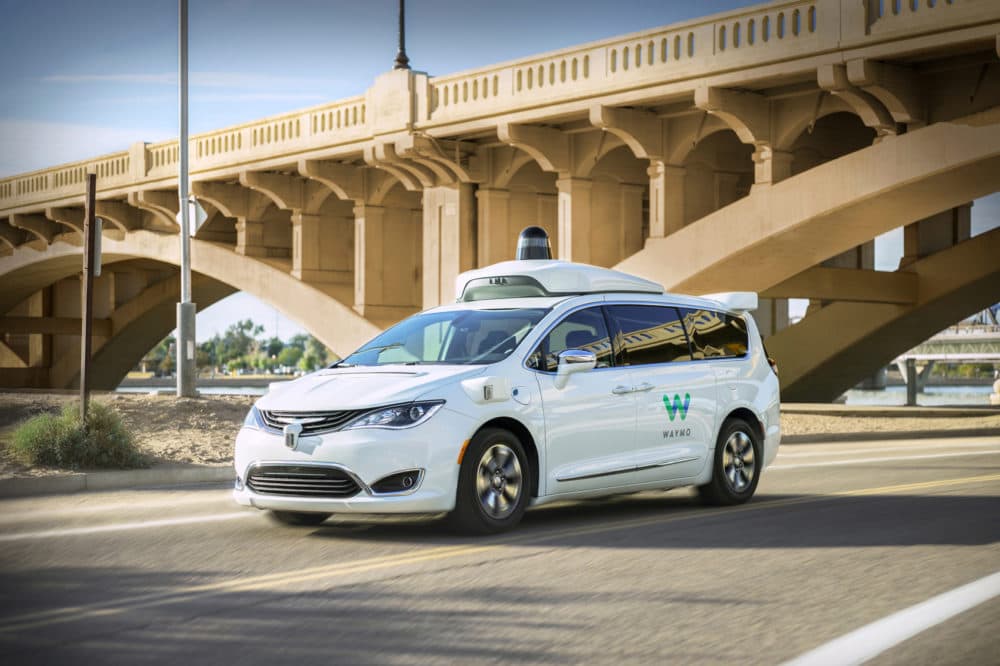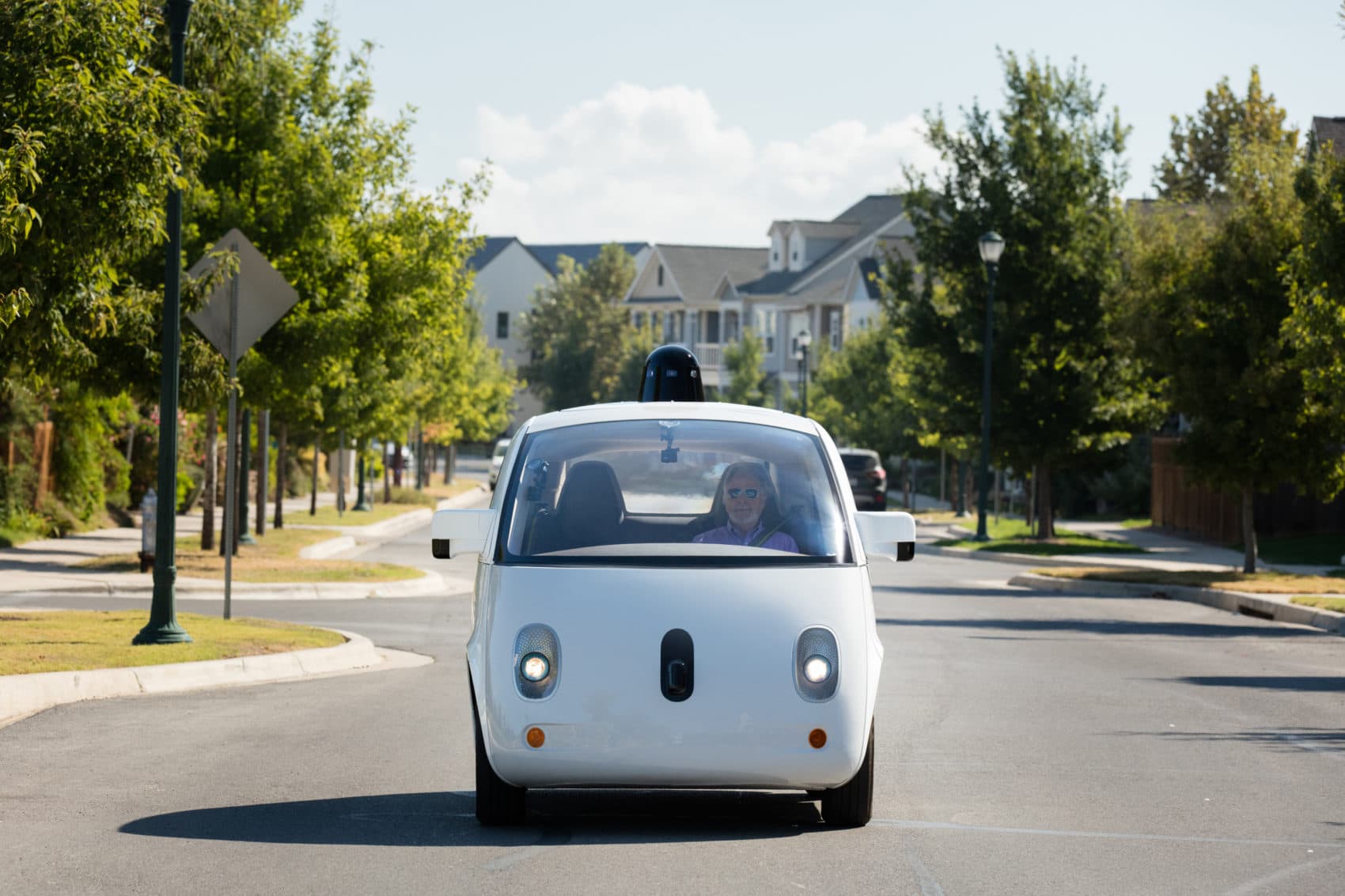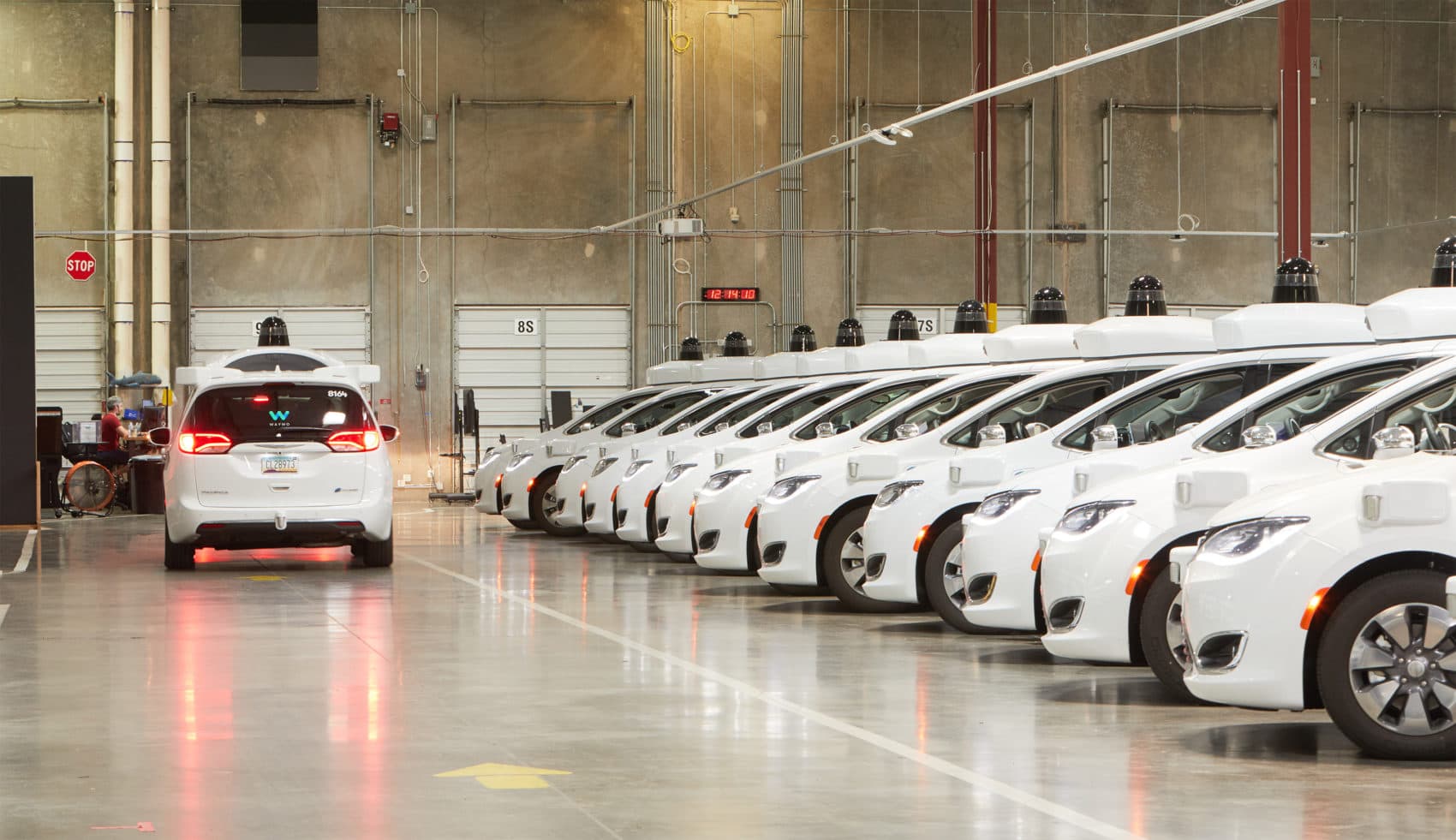Advertisement
Uber, Lyft ... And Now Waymo: The Self-Driving Car Service Hits The Road

With Meghna Chakrabarti
There’s now an app to hail a self-driving taxi. We’ll look behind the wheel at the technology and safety concerns.
Guests
Andrew Hawkins, senior transportation reporter at The Verge. He took a ride in a "Waymo One" taxi one week before the launch of the autonomous ride-hailing service in the Phoenix suburbs. (@andyjayhawk)
Rob Antoniak, chief operating officer of Valley Metro, which helps oversee the Phoenix metropolitan area’s transit system. (@RobRants)
Missy Cummings, professor of mechanical engineering at the Duke University Pratt School of Engineering. Director of the Humans and Autonomy Lab. (@missy_cummings)
Dave Ferguson, president of Nuro, a robotics company that has created a custom autonomous vehicle for the delivery of goods.
Interview Highlights
On the rise of ride-hailing services and autonomous car technology, and how the transportation landscape is changing thanks to companies like Waymo
Rob Antoniak: "We engaged with them. About a year and a half, two years ago, you could drive through and maybe see one or two vehicles. Now you see them every single day when you're driving around, as I did this morning. There's this natural evolution that's happening in transportation, and specifically in public transportation, as you watch the influence of transportation network companies such as Lyft and Uber and what they're doing to the market, and what they've done to the cab industry. And you reflect and you look in the mirror as a responsible leader in public transportation and say, 'Hey, what can we be doing to make sure we don't end up like the cab industry here?' And seeing that the technology was here, live and in person, and in Chandler [Arizona] as they reach that 10 million-mile mark over the course of the last year, which they were very public about announcing, we started to ask ourselves what could we do together? And we had met probably in early or late 2017 and realized that we had some common core values in the sense of our approach to safety, mobility, getting time back in people's calendar and then also the most effective and efficient use of public infrastructure. So it was with that launchpad, those four core values, we started to ask ourselves, 'What could we do and what would Waymo mean — how does it complement our region's public transit services?' "
Advertisement

On what it's like riding in these cars with "safety drivers"
RA: "I've done several rides inside the vehicles. It was fascinating. For me it's not just about how does it complement our region's public transit system. For me, personally, having started my career in Mesa Fire Department just east of Phoenix doing public information and training firefighters and police officers in our state about airbag safety and occupant protection systems and what does it mean to be in a crash — in the 15 years I've been commuting to downtown Phoenix, roughly 19-mile commute, I've had three cars totaled, none of which have been my fault, all avoidable situations. In a matter of minutes, watched this technology work, in a fascinating way as somebody that's been a victim of three crashes, and saw it do its thing, and saw it avoid circumstances that very much could have contributed to the demise of others around them. I couldn't experience it soon enough. I wanted to get my kid in it, wanted to get my wife in it, haven't done that yet. But my experience was I actually felt much more safe sitting in the back seat of that car than I do sitting behind the driver's seat of my own car."
Andrew Hawkins: "It did feel very safe. These cars are programmed to be that way, they're programmed to be very cautious. I said in the story that I wrote last week that it can, at times, feel as if you're riding in the back seat with a very cautious student driver, because there are moments when the car will certainly hesitate to make certain decisions, especially in more sort of complex driving scenarios, like, for instance, an unprotected left-hand turn where there's no traffic signals, or lights, or anything like that to help guide the car sensors. It was a couple moments like that where you sort of notice the car hesitating maybe a little bit longer than a human driver would. Now, is that a good thing? Do we want vehicles on the road that are more cautious and take longer to process some of these decisions? Some would argue yes, that's going to lead to maybe more safe conditions, but then when you consider the fact that 99 percent of the cars on the road today are human-driven ones and they're also going to be the ones interacting with these robot-driven cars, that could lead to tense situations, especially if you consider how impatient human drivers can when confronting even just a student driver or someone who's less experienced. There's been some reporting about how folks in the Phoenix area have found some of these vehicles to be annoying when they encounter them on the road because there is this cautiousness built into them. They'll drive around them if they have to and break the law."
"Waymo knows that if there is another death, particularly someone like the pedestrian like what happened in Tempe, it will shut the entire program down."
Missy Cummings
On the long-run hope for self-driving vehicles
RA: "Selfishly, it's about mobility. Whether it's for me personally for any one of our 250,000 daily riders, trip-takers. One of the challenges we have, being the fifth largest city in the nation, we're the 25th or 20th largest public transit agency. So we're way undersized for our population. Some of the biggest challenges come in communities like Chandlers where the headways for a bus — the listeners in Boston and New York will not appreciate the fact that you might have to go out on a curb here and wait for a bus for 30 to 45 minutes. You don't have to do that — I didn't have to do that in San Francisco growing up. ... Bringing autonomous vehicles and transportation network companies into the fold with us and learning how we can partner together to see how the services influence improving the options for residents to get into the network, how do we improve the transit user's experience, does it change our revenue models, those are the kinds of things that we're having conversations with Waymo about."
On why right now may or may not be the right time for deploying this technology
Dave Ferguson: "I think it depends a little bit what we mean by deployment. For me, personally, I'm very excited to see progress being made toward realizing the promise of this technology, which I think most of us agree is pretty profound when we look at how many lives we're losing on roads every year, just in the U.S. I think in terms of when is it ready, I think we need to be pretty serious about what we mean by what we're deploying. So, for instance, I think Waymo has recently, as of last week, deployed a service that frankly feels like something that is very ready. They have a safety driver in the vehicle, they've been testing this for years in the area that they're operating in. I think that deployments like that, I feel like we can all have quite a lot of confidence, are being done in a way that is very safe and for which the technology is pretty ready."

Missy Cummings: "This most recent move by Waymo, who — and I'm a big fan of what they're doing, and as a robotics professor I'm all about the advancement of this technology — but the reality is, this was a move just to get investor hype and drive up the stock rise. Nothing new is happening here, and, in fact, we could say it's a reversion. OK, so now people can pay for an Uber ride, is what they're basically saying. There's a safety driver in the driver's seat, which is actually — at one point during this limited testing they had in that environment, they had actually taken the driver out of the seat. So now, what they've done — and people aren't saying this — look, they put a driver back in the seat. They did that — I don't have any insider knowledge, but as an engineering professor I can guess — they did it because there were problems in the perception system, and they certainly — Waymo knows that if there is another death, particularly someone like the pedestrian like what happened in Tempe, it will shut the entire program down. The best part about what they're doing is to find out if people will pay for it. I think that they're about to find out that they should've done a business case a little bit earlier because I think this is probably not going to come out the way they want it to."
"My experience was I actually felt much more safe sitting in the back seat of that car than I do sitting behind the driver's seat of my own car."
Rob Antoniak
From The Reading List
CNBC: "Waymo starts commercial ride-share service" — "After months of testing and millions of miles developing self-driving vehicle technology, Waymo has officially launched the country's first commercial autonomous ride-share service.
"The company's Waymo One program will give customers rides in self-driving vehicles 24 hours a day. Initially, the service will be limited to cities surrounding Phoenix, including Tempe, Mesa and Chandler.
"While there may be many potential customers who want to ride in an autonomous vehicle, the Waymo One service will initially be offered to a limited number of people. Those customers will include hundreds of people in the Phoenix area who were test users of the Waymo self-driving vehicle fleet that has been in development since April 2017.
"'Self-driving technology is new to many, so we're proceeding carefully with the comfort and convenience of our riders in mind,' said Waymo CEO John Krafcik. One example of Waymo taking a cautious approach rolling out its ride-share service is the company's use of safety drivers to supervise the rides, at least initially. In addition, the company's app and consoles in the Waymo One vehicles will allow riders to instantly connect with support agents who can assist riders with questions.
"Alphabet's Waymo One marks the start of the race by automakers, tech companies and other firms to launch autonomous ride-share services. General Motors subsidiary Cruise plans to launch a similar service using self-driving vehicles next year."
The Verge: "Riding in Waymo One, The Google Spinoff's First Self-Driving Taxi Service" — "It is late afternoon in Chandler, a suburb of Phoenix, Arizona, and I’m getting jittery waiting for my self-driving car to make a left turn before arriving at the coffee shop. Seconds tick by, and the vehicle — an autonomous Chrysler Pacifica minivan owned by Waymo — is letting too many opportunities pass by without turning. But before I can get truly annoyed, the Waymo vehicle makes the left, and my mid-afternoon caffeine fix is soon satiated.
"Waymo, the self-driving subsidiary of Alphabet, launched its first commercial autonomous ride-hailing service here in the Phoenix suburbs on Wednesday — a momentous moment for the former Google self-driving project that has been working on the technology for almost a decade. I was one of the lucky few to test out the company’s robot taxi experience a week before the launch. And I say 'lucky' because to ride in one of Waymo’s autonomous minivans, not only do you have to live in one of four suburbs around Phoenix, but you also have to be in a very exclusive, 400-person club called the Early Riders.
"It’s not a motorcycle club for morning people, but rather Waymo’s year-and-a-half-old focus group for its self-driving cars. To start out, Waymo’s new self-driving taxi service — dubbed 'Waymo One' — will only be available to 'several hundred' members of the Early Rider program, said Dan Chu, head of product at Waymo. That’s exclusivity within exclusivity."
Slate: "Google’s Self-Driving Car Spinoff Waymo Launches Taxi Service in Arizona" — "Waymo, Google’s self-driving car spinoff, launched a taxi service in four Phoenix suburbs on Wednesday. Called Waymo One, the service will initially be available to people who participated in the company’s “early rider” pilot program and will gradually roll out to the general public.
"'There’s a long journey ahead, but we believe that Waymo One will make the roads safer and easier for everyone to navigate,' Waymo CEO John Krafcik wrote in a statement.
"Customers are now able to hail Waymo’s self-driving cars 24/7 using an app in which they can enter their pickup locations and destinations. While en route, riders can track the progress of the trip and ask for help from a support agent using the consoles located throughout the car—a Chrysler Pacifica minivan. Each car can fit three adults and one child."
This article was originally published on December 10, 2018.
This program aired on December 10, 2018.